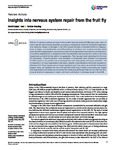Insights into nervous system repair from the fruit fly
| dc.contributor.author | Coupe, D | |
| dc.contributor.author | Bossing, Torsten | |
| dc.date.accessioned | 2022-05-03T10:27:05Z | |
| dc.date.available | 2022-05-03T10:27:05Z | |
| dc.date.issued | 2022-04 | |
| dc.identifier.issn | 2059-6553 | |
| dc.identifier.issn | 2059-6553 | |
| dc.identifier.uri | http://hdl.handle.net/10026.1/19138 | |
| dc.description.abstract |
<jats:title>Abstract</jats:title> <jats:p>Millions of people experience injury to the central nervous system (CNS) each year, many of whom are left permanently disabled, providing a challenging hurdle for the field of regenerative medicine. Repair of damage in the CNS occurs through a concerted effort of phagocytosis of debris, cell proliferation and differentiation to produce new neurons and glia, distal axon/dendrite degeneration, proximal axon/dendrite regeneration and axon re-enwrapment. In humans, regeneration is observed within the peripheral nervous system, while in the CNS injured axons exhibit limited ability to regenerate. This has also been described for the fruit fly Drosophila. Powerful genetic tools available in Drosophila have allowed the response to CNS insults to be probed and novel regulators with mammalian orthologs identified. The conservation of many regenerative pathways, despite considerable evolutionary separation, stresses that these signals are principal regulators and may serve as potential therapeutic targets. Here, we highlight the role of Drosophila CNS injury models in providing key insight into regenerative processes by exploring the underlying pathways that control glial and neuronal activation in response to insult, and their contribution to damage repair in the CNS.</jats:p> | |
| dc.format.extent | NS20210051- | |
| dc.format.medium | Electronic-eCollection | |
| dc.language | en | |
| dc.language.iso | en | |
| dc.publisher | Portland Press | |
| dc.subject | CNS damaga | |
| dc.subject | axon regrowth | |
| dc.subject | axonal injury | |
| dc.subject | cell proliferation | |
| dc.subject | glial injury | |
| dc.title | Insights into nervous system repair from the fruit fly | |
| dc.type | journal-article | |
| dc.type | Journal Article | |
| dc.type | Review | |
| plymouth.author-url | https://www.ncbi.nlm.nih.gov/pubmed/35474685 | |
| plymouth.issue | 1 | |
| plymouth.volume | 6 | |
| plymouth.publication-status | Published | |
| plymouth.journal | Neuronal Signaling | |
| dc.identifier.doi | 10.1042/ns20210051 | |
| plymouth.organisational-group | /Plymouth | |
| plymouth.organisational-group | /Plymouth/Faculty of Health | |
| plymouth.organisational-group | /Plymouth/Faculty of Health/Peninsula Medical School | |
| plymouth.organisational-group | /Plymouth/REF 2021 Researchers by UoA | |
| plymouth.organisational-group | /Plymouth/REF 2021 Researchers by UoA/UoA03 Allied Health Professions, Dentistry, Nursing and Pharmacy | |
| plymouth.organisational-group | /Plymouth/Research Groups | |
| plymouth.organisational-group | /Plymouth/Research Groups/Institute of Translational and Stratified Medicine (ITSMED) | |
| plymouth.organisational-group | /Plymouth/Research Groups/Institute of Translational and Stratified Medicine (ITSMED)/CBR | |
| plymouth.organisational-group | /Plymouth/Users by role | |
| plymouth.organisational-group | /Plymouth/Users by role/Academics | |
| dc.publisher.place | England | |
| dcterms.dateAccepted | 2022-03-29 | |
| dc.rights.embargodate | 2022-5-4 | |
| dc.identifier.eissn | 2059-6553 | |
| dc.rights.embargoperiod | Not known | |
| rioxxterms.versionofrecord | 10.1042/ns20210051 | |
| rioxxterms.licenseref.uri | http://www.rioxx.net/licenses/all-rights-reserved | |
| rioxxterms.type | Journal Article/Review |


